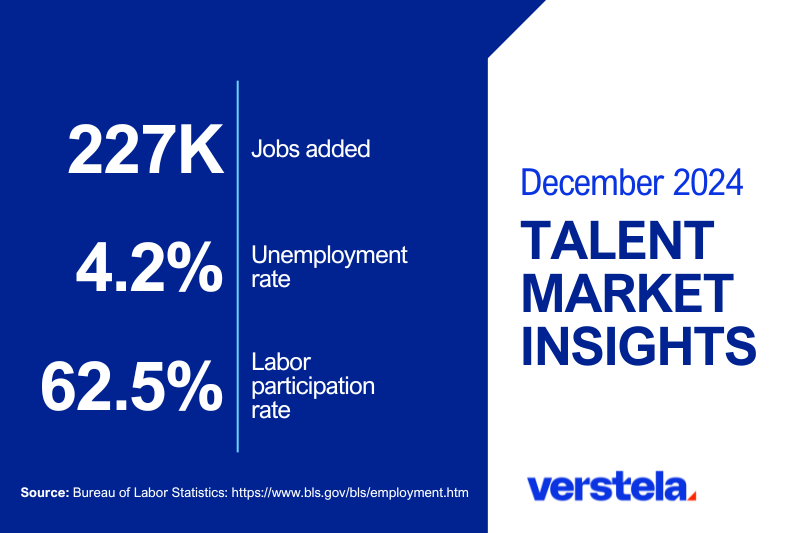
The latest jobs report revealed a rebound in job growth for November. However, job growth varied across industries, and hiring trends reflect a cautious approach from employers.
Here are some of the key takeaways:
- 227,000 jobs were added in November
- Unemployment inched up from 4.1% in October to 4.2% in November
- Workforce participation dipped slightly from 62.6% to 62.5%
- Wage growth increased by 0.4% month over month—the same increase throughout the year
Let’s dive into the latest labor market trends and explore what this means for employers.
Number of Jobs Available
In November, job growth bounced back after October’s unusually slow pace, as workers re-entered the labor force following the disruptions caused by labor strikes and hurricanes. Job gains for September and October were revised upward by a combined 56,000, reflecting adjustments to previously reported labor market data.
Healthcare led the way with 54,000 jobs added, followed by leisure and hospitality with 53,000, government with 33,000, and transportation equipment manufacturing with 32,000.
Retail trade shed 28,000 jobs, which contrasts with seasonal trends typically seen ahead of the holidays.
Unemployment
The unemployment rate edged up to 4.2% in November, compared to 4.1% in the previous month and 3.7% this time last year, indicating changes in unemployment trends.
The number of unemployed people has also increased over the last year by 800,000, from 6.3 million to 7.1 million. And people are staying unemployed for a longer period of time, on average 23.7 weeks—about six months—which is the highest duration since April 2022 when the average was 24.8 weeks.
Meanwhile, in the latest JOLTS report, which shows hires and separations for October, employers showed little change in layoffs, suggesting stability in workforce retention.
Wage Growth and Workforce Participation
Workforce participation slightly dipped from 62.6% to 62.5%, and has remained between a narrow range of 62.5%-62.8% since February 2023. Workforce participation has remained nearly unchanged for almost two years.
And wage growth increased by 0.4% month over month in November, and by 4% over the last year, indicating a consistent pattern of wage growth over the past year.
Economic variables to keep an eye on
The Federal Reserve is scheduled to meet on December 16-17 to discuss potential changes to interest rates. Any adjustments could influence consumer spending and broader economic conditions.
Additionally, tariffs may be imposed for goods coming from Mexico, Canada and China when President-elect Donald Trump takes office in January, which could influence business costs for sectors in a wide variety of industries. Some businesses are already preparing for the proposed tariffs.
Winning Moves for Employers
In today’s job market, employers need strategies that attract top talent, support their teams, and maintain a competitive edge through economic changes.
Here are some key tips for success:
- Focus on retention and workforce stability
With hiring slowing and layoffs remaining steady, retention is more critical than ever. Invest in initiatives that promote career development, employee engagement, and long-term satisfaction, such as mentorship programs, upskilling opportunities, and competitive benefits. - Address the evolving needs of job seekers
The rising unemployment rate and extended average duration of unemployment present opportunities to tap into a larger talent pool. Refine your recruitment strategy to appeal to job seekers seeking stability, career transitions, or re-entry into the workforce. - Leverage flexible staffing solutions
Temporary and contingent staffing can help you address fluctuating demand, particularly in unpredictable market conditions. Partnering with a staffing agency can ensure you have the right workforce in place without compromising productivity.
Want more resources? Explore our employer resource center. There, you’ll find an archive of on-demand HR webinars, tools and articles to help you address a variety of workplace challenges.
For additional insights into market trends, or if you need staffing support, contact us.


